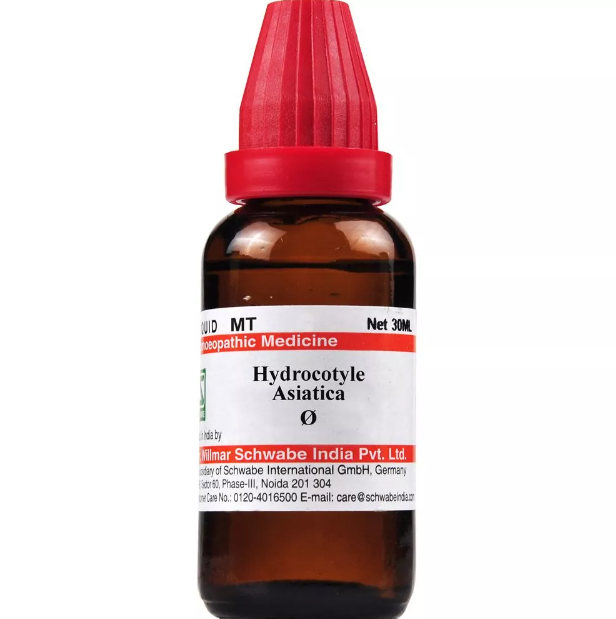HYDROCOTYLE ASIATICA Q, 6C, 12C, 30C, 200C, 1M, 10M USES AND SYMPTOMS
 HYDROCOTYLE ASIATICA
HYDROCOTYLE ASIATICA
(Indian Pennywort)
Hydrc.
Effective for disorders with interstitial inflammation and cellular proliferation. Useful for hypertrophy and hardening of connective tissue. Notable for treating leprosy and lupus without ulceration, and important for skin symptoms. Beneficial for uterine ulceration and difficulty in maintaining an upright position, with copious perspiration and cervical cancer pains.
Face: Pain in left cheekbone.
Female: Vaginal itching, inflammation of bladder neck, vaginal heat, granular uterine ulceration, profuse leucorrhea, dull ovarian pain, cervical redness, severe labor-like uterine pain.
Skin: Dry eruptions, thickened epidermis, exfoliation (ichthyosis), psoriasis on trunk and extremities, palms and soles, chest pustules, circular scaly spots, intolerable itching (especially soles), profuse sweat, syphilitic issues, acne, leprosy, elephantiasis (Ars.), lupus non-exedens.
Relationship: Compare with Elaeis guineensis (scleroderma, elephantiasis, leprosy, skin thickening, itching, hardening, anesthesia), Hura, Strychnos gaultheriana (serpent bites, ulcers, skin issues). Chaulmoogra oil (Tarakiogenos seeds), Hydr., Ars., Aur., Sep.
Dose: First to sixth potency.
SYMPTOMS OF HYDROCOTYLE ASIATICA
Face:
Pain in the left cheekbone.
Female:
Vaginal itching.
Bladder neck inflammation.
Internal vaginal heat.
Granular uterine ulceration.
Profuse leucorrhea.
Dull ovarian pain.
Cervical redness.
Severe labor-like pain in uterus and appendages.
Skin:
Dry eruptions.
Thickened epidermoid layer with exfoliation (ichthyosis).
Psoriasis gyrata on trunk, extremities, palms, and soles.
Chest pustules.
Circular spots with scaly edges.
Intolerable itching, especially on soles.
Profuse sweat.
Syphilitic conditions.
Acne.
Leprosy.
Elephantiasis (Ars.).
Lupus non-exedens.
selection of the potency
Individualization:
- Homeopathy is based on the principle of treating the individual, not just the disease. The unique symptoms and characteristics of the person are crucial in determining the most suitable potency.
Intensity of Symptoms:
- The intensity of the symptoms guides the choice of potency. If the symptoms are intense and acute, a lower potency (e.g., 6C, 30C) might be considered. For chronic conditions with less intensity, higher potencies (e.g., 200C, 1M) may be appropriate.
Sensitivity of the Patient:
- Some individuals are more sensitive to homeopathic remedies, while others may require higher potencies. The practitioner considers the patient’s sensitivity when selecting the potency.
Acute vs. Chronic Conditions:
- Lower potencies are often used for acute conditions, while higher potencies may be considered for chronic or long-standing issues.
Previous Response to Potencies:
- The patient’s response to previous homeopathic treatments helps guide the choice of potency. If a particular potency has been effective in the past, it may be repeated or adjusted as needed.
Vital Force and Susceptibility:
- Homeopathy views illness as a disturbance in the vital force. The practitioner assesses the patient’s overall vitality and susceptibility to determine the appropriate potency.
Aggravation or Amelioration:
- The direction of the symptom response (aggravation or amelioration) after taking a remedy can influence the choice of potency.
Miasmatic Considerations:
- In classical homeopathy, the concept of miasms (inherited disease tendencies) is considered. The practitioner take this into account when selecting the potency.
Practitioner Experience:
- The experience and preference of the homeopathic practitioner play a role. Some practitioners may have success with certain potencies based on their clinical experience.
SAFETY INFORMATION
- Do not exceed the recommended dose by physician
- Keep out of the reach of children
- Store in a cool dry place away from direct sunlight
- Maintain half an hour gap between food/drink/any other medicines and homoeopathic medicine
- Avoid any strong smell in the mouth while taking medicine e.g. camphor, garlic, onion, coffee, hing
Medicine images use for reference only selection of homeopathic medicine depends on the individual’s specific symptoms and overall constitution. Moreover, homeopathy is a holistic system of medicine that treats the individual as a whole. In addition to addressing the physical symptoms, it takes into account the emotional and mental state of the person. Consequently, it’s crucial to consult with a qualified homeopathic practitioner for personalized treatment.
The information provided on this website is intended solely for educational purposes. Always seek the advice of your physician or other qualified health provider.
